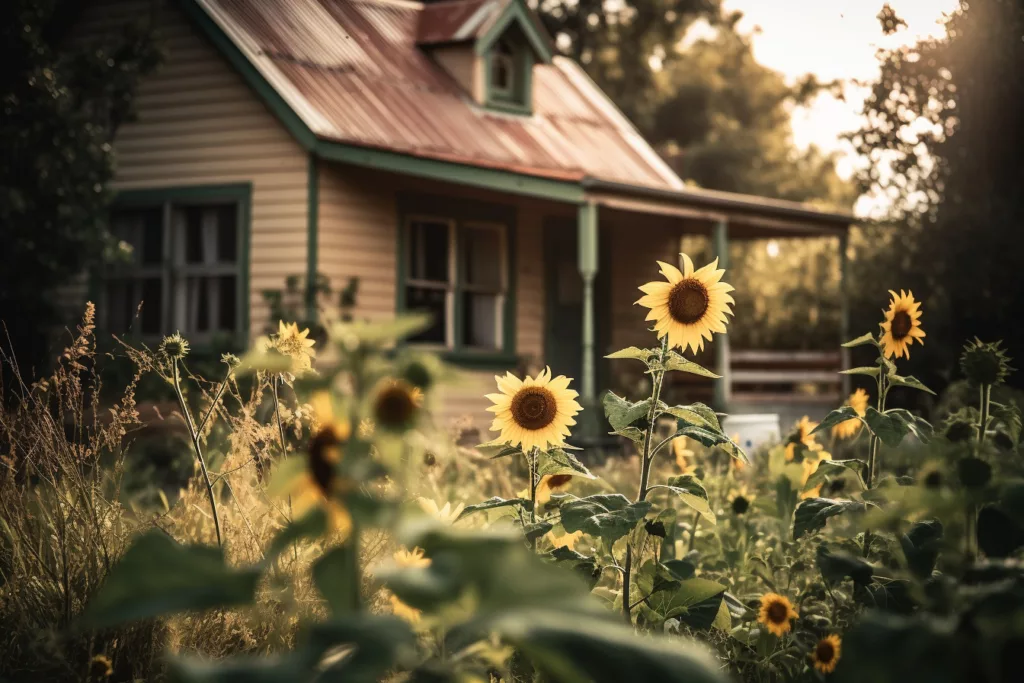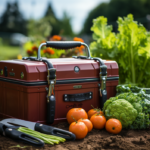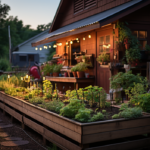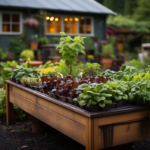Table of Contents
Add a Delicious Twist to Your Culinary Creations with These 10 Handpicked Edible Flowers
Hey there, fellow foodies! Are you tired of cooking the same old dishes day after day? Want to spice up your culinary creations with a little something different? Well, have you ever thought about adding edible flowers to your kitchen garden? Not only are these flowers pretty to look at, but they’re also tasty and can add a unique flavor to your dishes. In this article, we’ll introduce you to ten tasty and unique edible flowers that you might just fall in love with. So, roll up your sleeves and get ready to learn about some of the best flowers to grow in your kitchen garden!
Sunflower
Sunflowers are a beautiful addition to any garden, and many people forget that they are edible, too. The petals of the sunflower are the part that you can eat, and they have a slightly sweet flavor with a hint of bitterness. If you grow your own sunflowers, you can be sure that they haven’t been treated with any pesticides or other chemicals.
Growing Sunflowers
Sunflowers are pretty easy to grow, and they can be started from seed in the spring. They’ll need full sun and well-draining soil to thrive. If you plant sunflowers in a spot with too much shade, they will likely grow tall and leggy. Plus, they might not produce as many flowers.
Harvesting Sunflowers
You can start harvesting sunflowers once they start to bloom. Just make sure to pick them before they start to wither. To harvest the petals, pluck them gently from the flower head. You can use the petals as a garnish or add them to salads or sandwiches for some extra color and flavor.
Cooking with Sunflowers
Sunflower petals can be used in a variety of dishes, both sweet and savory. If you like pickles, try adding some sunflower petals to the brine for a pop of flavor. You can also make sunflower pesto by blending together the petals, some garlic, parmesan cheese, and olive oil. Sunflower petals can also be used in baked goods, like bread or muffins, for a unique twist.
Considerations
It’s important to note that some people may have an allergic reaction to sunflower petals. If you are trying them for the first time, start with a small amount and see how your body reacts. Additionally, you should avoid eating any flowers that have been treated with pesticides or other chemicals. Always make sure to wash them thoroughly before you eat them.
In conclusion, growing sunflowers in your kitchen garden can add both beauty and flavor to your dishes. They’re easy to grow, and you can harvest them throughout the summer. Plus, they make a unique addition to many different recipes. Just remember to take any necessary precautions and enjoy experimenting with this tasty and unique edible flower!
Nasturtium
Looking for a unique and flavorful addition to your kitchen garden? Consider planting some nasturtium. This colorful flower features bright hues of orange, yellow, and red and comes in a variety of shapes and sizes.
Flavor Profile
Nasturtiums have a tangy and peppery taste that’s similar to watercress. They’re an excellent addition to salads or sandwiches as they add a spicy kick.
Growing Requirements
The great thing about nasturtiums is that they’re easy to grow and require minimal maintenance. They thrive in sunny locations and prefer well-draining soil. These flowers are also drought-resistant, so you don’t need to water them too frequently.
Harvesting
You can start harvesting nasturtium flowers as soon as they begin to bloom. The flowers can be used fresh or dried, making it easy to incorporate them into your favorite dishes year-round.
Recipes
There are many ways to use nasturtiums in your culinary creations. Here are a few recipes to get you started:
- Nasturtium and Walnut Pesto: Combine nasturtium leaves and flowers with walnuts, garlic, olive oil, and Parmesan cheese in a food processor. Serve over pasta or as a spread for bread.
- Cream Cheese and Nasturtium Bagels: Spread cream cheese on a bagel and top with nasturtium flowers and leaves for a simple yet flavorful breakfast.
- Nasturtium Butter: Cream together softened butter and chopped nasturtium leaves and flowers. Serve with bread or use as a topping for grilled meats.
Nasturtiums are a unique and flavorful addition to any kitchen garden. They’re easy to grow and can add a peppery kick to your favorite dishes. Try incorporating them into your meals today for a fun and delicious twist.
Calendula
Looking for a beautiful flower that’s both edible and medicinal? Look no further than Calendula, also known as Pot Marigold. This bright, cheerful flower is not only a showstopper in your garden, but it also has a long history of use in traditional medicine and culinary applications.
Health Benefits of Calendula
Calendula is highly regarded for its therapeutic properties and offers a range of health benefits, including:
- Anti-inflammatory properties: Calendula contains anti-inflammatory compounds that may help reduce inflammation and pain, making it useful for treating various inflammatory conditions such as arthritis and sore throat.
- Skin healing: Calendula’s healing properties help soothe and repair damaged skin, making it a natural remedy for cuts, scrapes, burns, and other skin irritations.
- Antioxidant-rich: Calendula is rich in antioxidants that may help protect your body against oxidative stress and damage caused by free radicals, thereby promoting overall well-being.
Growing Requirements
Calendula is easy to grow, making it an ideal choice for beginners. Here are some things to keep in mind when growing Calendula:
- Sun Exposure: Calendula thrives in full sun or partial shade, so make sure to plant it in a spot that receives at least six hours of direct sunlight each day.
- Soil Type: Calendula prefers well-draining soil, rich in organic matter. If you have heavy clay soil, amend it with compost or other organic material to improve drainage.
- Watering: Calendula needs regular watering to thrive, but avoid overwatering, as this can cause root rot. Water deeply once or twice a week, depending on weather conditions and soil moisture.
Culinary Uses
Calendula’s bright yellow and orange petals add a colorful and unique flavor to a range of dishes, including salads, soups, and stews. The petals have a slightly bitter taste, similar to saffron, and can be used fresh or dried. Some popular culinary applications include:
- Calendula tea: Steep fresh or dried petals in hot water for a soothing, caffeine-free tea that can help reduce inflammation and support overall health.
- Calendula butter: Mix finely chopped petals into softened butter for a colorful, flavorful spread that’s perfect on bread or baked potatoes.
- Calendula vinegar: Add fresh petals to white vinegar and let steep for a few weeks to create a flavorful infused vinegar that can be used in dressings, marinades, or as a finishing touch on roasted veggies.
In conclusion, Calendula is an excellent choice for anyone looking to add a beautiful and beneficial flower to their kitchen garden. Its hardy nature, therapeutic properties, and range of culinary applications make it a must-have in any garden.
Rose
Roses are a classic choice for bouquets, but did you know that they’re also edible? Not only do rose petals provide a sweet and fragrant flavor, but their beautiful color also makes them a stunning garnish for many dishes. Here are some essential aspects of this edible flower that you should keep in mind if you’re thinking of growing them in your kitchen garden.
Growing Roses for Cooking
Roses grow best in areas with cool, moist weather, although they can thrive in a variety of conditions. If you’re interested in growing roses for cooking, make sure you select roses that are free from pesticides and insecticides. Also, choose roses with the best aroma for the most flavorful petals. It’s best to harvest the petals in the morning when the roses are freshly opened and at their most fragrant.
Culinary Uses of Roses
Roses are not only beautiful to look at, but they’re also versatile in the kitchen. Here are some ways to use rose petals in your cooking:
- Candied rose petals: Coat the petals in egg whites, sprinkle with sugar, and let them dry overnight for a tasty and fragrant dessert topping.
- Rosewater: Steep the petals in water and use the infused liquid to add an aromatic taste to beverages, baked goods, or savory dishes.
- Rose petal jam: Simmer petals with sugar, lemon juice, and water to create a sweet and flowery jam that’s perfect for spreading on toast.
Tips for Cooking with Roses
If you’re new to cooking with edible flowers, here are some tips to keep in mind:
- Use only the petals- the center of the rose can be bitter.
- A little goes a long way- use them sparingly to prevent overpowering flavors.
- Pair them with complementary flavors- they pair well with berries, citrus, and chocolate.
Conclusion
Roses are an elegant and delicious choice for any kitchen garden, adding a sweet and flowery flavor to your favorite recipes. Whether you’re using them to create a perfect garnish or adding them to preserve, it is always a great idea to experiment with new tastes. Once you try cooking with roses, you’ll be hooked!
Lavender
One of the most popular flowers used in many products is lavender, and it can be used for cooking too. Lavender has a sweet, fragrant flavor that gives dishes an elegant and unique floral touch. Here are some essential aspects of lavender in cooking:
Growing Lavender at Home
Lavender thrives in full sunlight, so it’s important to plant it in a spot where it can get the necessary amount of sun.
- Lavender grows best in sandy, well-drained soil, and needs moderate watering once a week.
- The best time to plant lavender is in the spring when the soil temperatures start to warm up.
- Use seedlings or cuttings to plant lavender since they are the easiest and most popular way to propagate the herb.
Using Lavender in Your Kitchen
Lavender is a great herb that enhances the flavor of many dishes. But, it should be used sparingly since it has a strong flavor. Here are some ways you can use lavender in your kitchen:
- Add a small amount of lavender to flour when baking scones, cakes, or other pastries.
- Infuse lavender buds in hot water to make a tea.
- Make lavender sugar by blending lavender buds and sugar in a food processor.
- Lavender can be used in savory dishes too. Mix a small amount of dried lavender with any herb like thyme, rosemary, or sage and add it to marinades or sauces.
Lavender is an easy-to-grow herb that has a unique flavor that can lift any dish. Its fragrant flavor makes it an ideal addition to sweet or savory recipes. Adding lavender to your kitchen garden will provide you with fresh herbs to use throughout the year. Try adding a little bit of lavender to your next recipe and taste the difference it makes!
Dandelion
Are you tired of seeing dandelions take over your garden? Don’t knock them until you’ve tried them! This common weed has a surprising number of culinary uses and is full of nutrients. Here are the essential aspects to know about dandelions in your kitchen garden:
Taste Characteristics
Dandelion greens have a slightly bitter taste with a nutty undertone, and the flowers have a sweet, nectar taste. These two parts of the plant are edible and have different uses in the kitchen.
Nutritional Value
One of the best things about dandelions is their nutritional value. They contain vitamin C, fiber, potassium, and antioxidants. Plus, they’re a natural diuretic, which means they can help relieve water retention.
Uses in the Kitchen
Here are some creative ways to use dandelions in your meals :
- Salad greens: Young dandelion leaves can add a nice bite to your fresh green salad.
- Sautee: Cook the greens with garlic and olive oil for a tasty side dish.
- Tea: Dandelion flowers can be used to make a herbal tea.
Growing and Harvesting Tips
Dandelions grow almost anywhere, and you’re probably already well-stocked if you have a garden or yard. Here are some tips for growing and harvesting dandelions for your kitchen garden:
- Harvest only the leaves and flowers of the dandelion plant.
- Avoid harvesting from areas that may have been sprayed with herbicides or pesticides.
- Harvest the leaves when they’re young, and avoid the older leaves as they can be too bitter.
In conclusion, whether you’re looking for ways to use what you already have or want to experiment with something new, consider dandelions as a valuable addition to your kitchen garden.
Hibiscus
If you’re looking to add a tropical vibe to your garden or kitchen, look no further than hibiscus flowers. With their bright colors and bold flavors, hibiscus flowers are a unique and delicious addition to any culinary creation. Here are a few essential aspects of hibiscus flowers that you should know before growing them in your garden:
Flavor and Nutrition
Hibiscus flowers (Hibiscus sabdariffa) are also known as Roselle and have a tangy, citrus-like flavor that makes them great for adding to teas, jams, and sauces. They contain high levels of antioxidants, vitamin C, and minerals like zinc and iron, making them a great addition to your diet.
Growing Hibiscus
Hibiscus plants are native to tropical regions and prefer a warm, humid climate. In cooler climates, hibiscus can be grown as an annual, but in warm regions, they can persist as a perennial and grow into a large shrub. They prefer full sun to partial shade, well-draining soil, and regular water.
Harvesting and Using Hibiscus
The calyces (the fleshy, red part) of the hibiscus flower are the edible part. They can be harvested when they’re plump and juicy, which is typically in the late summer or fall. Once harvested, the calyces can be dried for use in teas or syrups. They can also be used fresh, either chopped up in salads or added to smoothies. The flowers themselves can also be used for culinary decoration, adding a pop of color and tropical flair to your dishes.
In Conclusion
If you’re looking for a unique and flavorful flower to add to your garden or kitchen, hibiscus is an excellent choice. With its tangy flavor and tropical flair, it’s sure to add a pop of color and flavor to any dish. So, why not give it a try and bring a little bit of the tropics into your home?
Borage
Are you looking for a unique and tasty addition to your kitchen garden? If so, you might want to consider growing some borage! This beautiful plant produces bright blue flowers that are not only pretty to look at but also edible. Here are some essential aspects of borage that you should know if you want to add it to your garden.
Appearance and Growth
Borage is an annual plant that is native to the Mediterranean and has naturalized in many parts of the world. The plant grows up to 2 feet tall and produces green, furry leaves and star-shaped flowers that are usually blue but can sometimes be pink or white.
Culinary Uses
The flowers and leaves of the borage plant have a slightly salty taste, making them an excellent addition to salads or soups. The flowers can also be used to decorate cakes, desserts, and cocktails, adding a distinctive touch of blue color to your creations.
Health Benefits
Borage flowers and leaves are rich in nutrients, including potassium, calcium, and vitamin C. They also contain gamma-linolenic acid (GLA), which is an omega-6 fatty acid that has anti-inflammatory properties. Some studies have suggested that borage may be useful in treating respiratory problems, skin conditions, and menstrual cramps.
Growing Tips
Borage is an easy plant to grow and thrives in most soil types, as long as it is well-draining. The plant prefers full sun but can tolerate partial shade. Borage self-seeds easily, so be sure to deadhead the flowers if you don’t want it to spread too much.
In Conclusion
Borage is a unique and versatile edible flower that is easy to grow and adds a distinctive touch to your culinary creations. If you’re looking for something a little different to add to your kitchen garden, give borage a try!
Chamomile
Are you looking for ways to add something unique and exciting to your kitchen garden? If you’re a fan of chamomile tea, then growing chamomile flowers is a must-try for you! This delicate-looking flower is an aromatic herb that has long been used in traditional medicine to promote relaxation, treat insomnia, and reduce anxiety.
What is Chamomile?
Chamomile, also known as Matricaria chamomilla, is an annual herb that belongs to the sunflower family. It has a daisy-like appearance and features white petals with a yellow center. Chamomile flowers have an apple-like fragrance and a slightly sweet flavor that works well in a variety of culinary recipes.
Why Grow Chamomile?
Aside from adding an extra pop of color and flavor to your garden, chamomile offers various benefits that make it ideal for beginners and experienced gardeners alike.
- Easy to grow: Chamomile is low maintenance and easy to grow. It typically thrives in well-drained soil and requires minimal watering.
- Versatile: This herb can be used in both savory and sweet dishes, making it a versatile addition to your kitchen garden.
- Helps attract beneficial insects: Chamomile’s white flowers can attract pollinators like bees and butterflies, making it an excellent choice for gardeners who want to promote a healthy ecosystem.
How to Use Chamomile in Cooking
From tea to jelly, chamomile flowers can be used to add a unique flavor and aroma to a variety of culinary creations. Here are a few simple ways you can incorporate chamomile into your cooking:
- Tea: Chamomile tea is perhaps the most popular way to enjoy chamomile flowers. Simply steep some fresh or dried chamomile flowers in hot water, add a little honey, lemon, or mint, and enjoy.
- Salad: Add some color and a floral aroma to your salad by mixing in some fresh chamomile flowers.
- Dessert: Chamomile flowers can be used to create an aromatic syrup for desserts like ice cream, sorbet, and panna cotta.
Chamomile is a versatile and easy-to-grow herb that can add a unique flavor and aroma to your culinary creations. Whether you use it in tea, salads, or desserts, chamomile is a fantastic addition to any kitchen garden. So why not give it a try and see how it can transform your dishes?
Pansy
Pansies are popular garden flowers that bloom in vibrant hues of blue, purple, yellow, and orange. These delicate flowers are not only beautiful but also edible! That’s right, pansies are a delicious and healthy ingredient that can add a pop of color and flavor to many dishes. Here are some essential aspects of growing and enjoying pansies in your kitchen garden.
Growing Pansies
If you want to grow pansies in your garden, follow these simple steps:
- Choose a location that receives plenty of sunlight (at least six hours per day).
- Prepare the soil by tilling or loosening the topsoil and enriching it with compost.
- Plant the pansy seeds in early spring or fall, about six inches apart, and water thoroughly.
- Pansies are known to grow in cooler weather, so make sure to water them regularly and avoid letting the soil dry out.
- Depending on your geographic location, pansies can bloom throughout spring, summer, or fall and may need to be replanted each season.
Using Pansies in Your Kitchen
Once your pansies are blooming, it’s time to start using them in your kitchen. Here are some ways you can incorporate these flavorsome flowers into your meals:
- Salad: Pansies add a colorful and flavorful touch to any salad. Sprinkle the petals and leaves over the top, or mix them in with the dressing for an extra kick of flavor.
- Desserts: Pansies are commonly used in desserts for their sweet flavor and vibrant colors. Add the flowers to cupcakes, cakes, or garnish a creamy dessert.
- Tea: Pansy tea is known for its calming effects, and some even say it helps with respiratory problems. To make pansy tea, simply steep the fresh flowers in hot water for a few minutes.
Pansies are not only beautiful in your garden, but also tasty in your kitchen. They are easy to grow and care for, and adding their colorful petals and flavor to your meals is sure to make them more memorable. So, next time you’re planning to plant a patch of pansies, be sure to consider incorporating them into your culinary creations too!
Conclusion
As you can see, edible flowers are not only beautiful to look at but also a delectable and unique ingredient to add to your cooking. From brightly-colored pansies to delicate chamomile, each of the ten flowers mentioned in this article has its own distinctive taste and nutritional benefits. Growing these flowers in your kitchen garden is both easy and rewarding, and can add a creative twist to your culinary creations. Don’t hesitate to experiment with these flavorful blooms and find out which ones suit your taste buds the best. So, why not give edible flowers a try and take your cooking to the next level?









